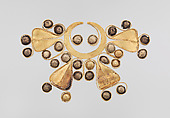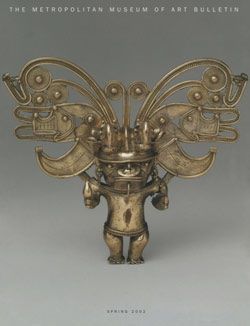Nose ornament
Tolita-Tumaco metallurgists deployed a wide array of techniques to transform gold—acquired as nuggets from riverbanks—and gold alloys, and sometimes silver or even platinum, into elaborate objects with intricate designs. Ornaments made of these precious metals were used to adorn bodies of the living but also the bodies of ceramic effigies. Such regalia reinforced chiefly authority and religious power. The Ecuadorian metallurgic tradition is characterized by the frequent use of fine metal wires and granulated beads, fusion gilding (joining parts by applying a thick metal coating on both surfaces) and combining different metals into alloys with different hues. Here, this delicate crescent-shaped nose ornament features four leaf-shaped forms bounded and connected with wires encircling twenty-six balls.
References and Further Reading
Pillsbury, Joanne, Timothy Potts, and Kim N. Richter, eds. Golden Kingdoms: Luxury Arts in the Ancient Americas. Los Angeles: J. Paul Getty Museum, 2017.
Quilter, Jeffrey, and Alexis Hartford. "Nose Ornaments: A General Typology and Moche Case Study." Res: Anthropology and Aesthetics 77, no. 1 (2022), pp. 283-302.
This image cannot be enlarged, viewed at full screen, or downloaded.


